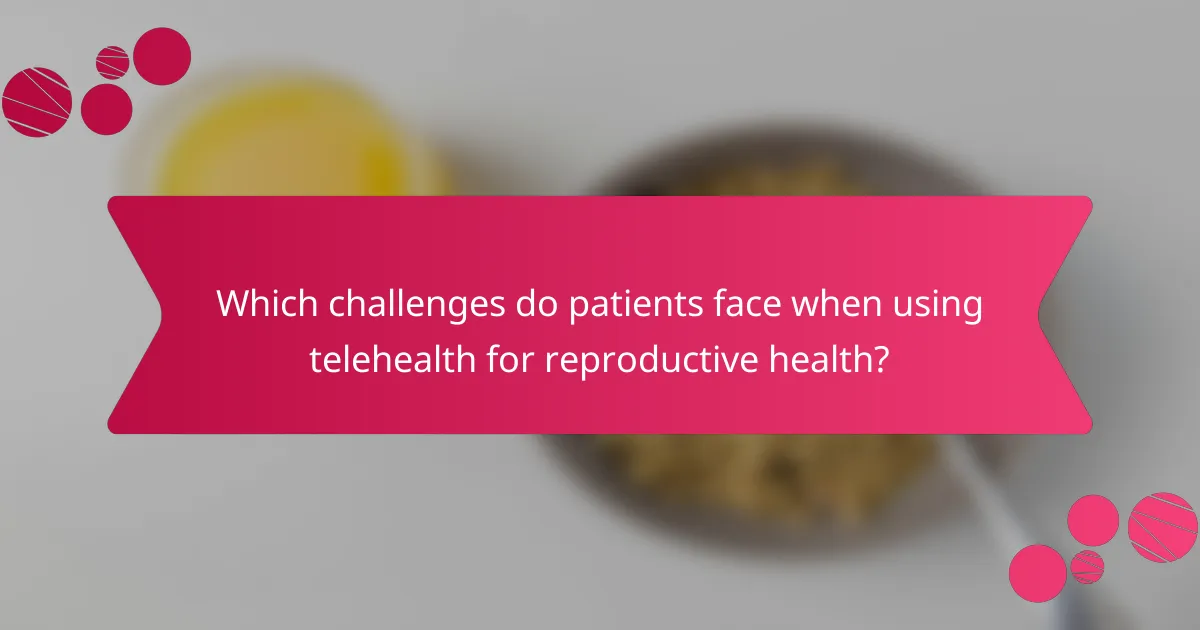Telehealth solutions significantly improve access to reproductive health services, overcoming geographical barriers and offering confidential consultations. Key technologies like secure video conferencing and electronic health records streamline care delivery. However, challenges such as technology access and privacy concerns must be addressed to enhance effectiveness. Understanding regional telehealth regulations is crucial for equitable implementation in reproductive health.

How do telehealth solutions enhance accessibility in reproductive health services?
Telehealth solutions significantly enhance accessibility in reproductive health services by removing geographical barriers and providing confidential consultations. Patients can access care from the comfort of their homes, improving convenience and reducing travel costs. Telehealth also offers flexible scheduling, accommodating various lifestyles and commitments. Additionally, it increases access for underserved populations, ensuring equitable healthcare delivery.
What are the key benefits of telehealth in reproductive health?
Telehealth enhances reproductive health by increasing accessibility, improving patient privacy, and reducing costs. It allows individuals to consult healthcare providers from home, facilitating timely care without travel barriers. Telehealth also supports continuous monitoring and follow-up, leading to better health outcomes. Additionally, it expands access to specialists, particularly in underserved areas.
Which populations benefit most from telehealth reproductive services?
Populations that benefit most from telehealth reproductive services include those in rural areas, low-income individuals, and patients with mobility issues. Telehealth improves access to care for these groups, reducing barriers such as travel and cost. Additionally, marginalized communities often face healthcare disparities, making telehealth a vital resource for equitable reproductive health services. Studies indicate that telehealth can enhance patient engagement and satisfaction, particularly among those who may feel stigmatized or uncomfortable in traditional settings.

What technologies are essential for effective telehealth reproductive health services?
Telehealth reproductive health services require secure video conferencing, patient management systems, electronic health records, mobile health applications, and remote monitoring tools. These technologies enhance accessibility and streamline care delivery. Secure video conferencing ensures privacy during consultations. Patient management systems facilitate scheduling and follow-ups. Electronic health records maintain comprehensive patient data. Mobile health applications offer convenient access to information and support. Remote monitoring tools enable ongoing health assessments.
How do video consultations compare to traditional in-person visits?
Video consultations offer increased convenience and accessibility compared to traditional in-person visits. Telehealth solutions allow patients to receive reproductive health services from the comfort of their homes, eliminating travel time and associated costs.
In-person visits may provide a more personal interaction, but video consultations can effectively address many health concerns, including routine check-ups and follow-ups. Studies show that telehealth can improve patient engagement and satisfaction, making it a valuable alternative in reproductive health services.
Video consultations can also reduce waiting times and enhance access for those in remote areas. While traditional visits may be necessary for certain procedures, telehealth continues to expand its role in accessible reproductive healthcare.
What role do mobile apps play in reproductive health telehealth?
Mobile apps significantly enhance reproductive health telehealth by providing accessible, confidential, and user-friendly platforms for patients. They facilitate remote consultations, enabling individuals to connect with healthcare providers from the comfort of their homes. This convenience promotes timely access to reproductive health services, which can improve health outcomes.
Moreover, mobile apps often include features like appointment scheduling, medication reminders, and educational resources. These attributes empower users with information and support, fostering proactive health management. As a result, mobile apps play a crucial role in bridging gaps in reproductive health access, particularly in underserved areas.

Which challenges do patients face when using telehealth for reproductive health?
Patients face several challenges when using telehealth for reproductive health, including limited access to technology, privacy concerns, and lack of personal interaction. These factors can hinder effective communication and reduce the quality of care.
Access to reliable internet and devices is crucial; however, many patients encounter barriers due to socioeconomic status. Privacy concerns may arise from sharing sensitive information over digital platforms, leading to reluctance in discussing personal health issues. Additionally, the absence of in-person consultations can diminish the patient-provider relationship, impacting trust and comfort levels.
Telehealth solutions must address these challenges to enhance accessibility and effectiveness in reproductive health services.
How can privacy and confidentiality be maintained in telehealth services?
Privacy and confidentiality in telehealth services can be maintained through secure communication platforms and strict data protection policies. Utilizing end-to-end encryption ensures that patient information remains confidential during consultations. Regular training for healthcare providers on privacy practices further enhances security. Compliance with regulations, such as HIPAA, establishes a framework for protecting sensitive health information. Additionally, obtaining informed consent from patients before sharing their data reinforces trust and transparency in telehealth interactions.
What are the limitations of telehealth in reproductive health care?
Telehealth in reproductive health care faces several limitations. These include technological barriers, limited physical examinations, and challenges in establishing patient-provider relationships.
Technological barriers can hinder access for patients without reliable internet or devices. Limited physical examinations may affect diagnosis and treatment, especially for conditions requiring hands-on assessments. Challenges in establishing rapport can impact the quality of care, as trust and communication are crucial in reproductive health.
Additionally, reimbursement policies for telehealth services may not fully cover all aspects of reproductive health, limiting provider participation. These factors collectively affect the overall effectiveness of telehealth solutions in this field.

How do telehealth regulations vary across regions for reproductive health services?
Telehealth regulations for reproductive health services vary significantly across regions. Factors influencing these differences include state laws, licensing requirements, and insurance coverage. For instance, some states allow telehealth consultations without in-person visits, while others mandate them. Additionally, reimbursement policies for telehealth services differ, affecting accessibility. Understanding these regional nuances is crucial for effective telehealth implementation in reproductive health.
What are the legal considerations for telehealth providers in reproductive health?
Telehealth providers in reproductive health must navigate various legal considerations, including licensing, patient privacy, and informed consent. Providers must be licensed in the states where patients reside, ensuring compliance with local regulations. Additionally, adherence to HIPAA regulations is crucial for protecting patient information. Informed consent must be obtained, detailing the nature of services and potential risks. Understanding malpractice liability is also essential, as telehealth may alter traditional standards of care. These factors collectively ensure that telehealth services are legally sound and ethically responsible.
How do reimbursement policies affect telehealth access in different regions?
Reimbursement policies significantly influence telehealth access by varying across regions. Areas with comprehensive reimbursement models see higher telehealth utilization, improving access to reproductive health services. In contrast, regions with limited coverage face barriers, restricting availability and affordability of these essential services. For instance, states that reimburse for a broad range of telehealth services report increased patient engagement and satisfaction. Additionally, disparities in policy enforcement can lead to unequal access, affecting marginalized communities disproportionately.

What unique services are offered through telehealth for reproductive health?
Telehealth offers unique reproductive health services such as remote consultations, personalized treatment plans, and access to specialists. These services enhance accessibility and convenience for patients. Telehealth allows for discreet communication, which can be particularly important for sensitive reproductive health issues. Additionally, it provides timely follow-ups and continuous monitoring, improving overall care quality.
How are mental health services integrated into telehealth reproductive care?
Mental health services are integrated into telehealth reproductive care through collaborative models that enhance accessibility and support. These services include virtual counseling, medication management, and crisis intervention tailored to reproductive health needs.
Telehealth solutions allow for timely access to mental health professionals, which is crucial for individuals facing reproductive health challenges. Studies indicate that approximately 50% of individuals seeking reproductive care also experience mental health issues, highlighting the importance of this integration.
By utilizing secure video conferencing and online resources, patients can receive comprehensive care without geographical barriers. This approach not only improves overall health outcomes but also fosters a supportive environment for discussing sensitive issues related to reproductive health.
As a result, integrated telehealth services bridge gaps in care, ensuring that mental health support is readily available alongside reproductive health services. This holistic model promotes well-being and empowers patients to make informed decisions about their reproductive health.
What specialized programs exist for maternal health through telehealth?
Telehealth programs for maternal health include remote consultations, prenatal monitoring, and postpartum support. These services enhance accessibility and convenience for expecting mothers. Programs often focus on education, mental health, and chronic condition management. Notable examples include virtual prenatal classes and teletherapy for postpartum depression. Such initiatives improve health outcomes and reduce barriers to care.

How can telehealth improve patient education and awareness in reproductive health?
Telehealth significantly enhances patient education and awareness in reproductive health by providing accessible information and resources. Patients can engage in virtual consultations, receive tailored educational materials, and access expert guidance from the comfort of their homes. This convenience fosters a better understanding of reproductive health topics, including contraception, fertility, and sexually transmitted infections. Telehealth services also facilitate ongoing communication, allowing patients to ask questions and clarify doubts, ultimately leading to informed decision-making. As a result, telehealth empowers individuals to take charge of their reproductive health and make educated choices.
What resources are available for patients seeking telehealth information?
Patients seeking telehealth information can access various resources. Telehealth platforms often provide comprehensive guides, FAQs, and live support for reproductive health services. Additionally, organizations like the American College of Obstetricians and Gynecologists offer educational materials and toolkits online. Local health departments may also have resources tailored to specific communities. Online forums and support groups can provide peer insights and experiences related to telehealth services.
How do telehealth platforms facilitate patient engagement and follow-up?
Telehealth platforms enhance patient engagement and follow-up through real-time communication, personalized care plans, and data tracking. They enable patients to access reproductive health services conveniently, fostering ongoing interaction with healthcare providers. Telehealth solutions facilitate reminders for appointments and medication adherence, improving overall health outcomes. Additionally, they often include educational resources, empowering patients to make informed decisions about their reproductive health.

What best practices should be followed for optimizing telehealth reproductive health services?
To optimize telehealth reproductive health services, prioritize user-friendly technology, ensure privacy, and provide comprehensive training for providers. Effective communication with patients enhances engagement and trust. Integrating mental health support is vital for holistic care. Regular feedback mechanisms improve service quality and patient satisfaction.
How can providers ensure a patient-centered approach in telehealth?
Providers can ensure a patient-centered approach in telehealth by prioritizing communication, accessibility, and personalized care. Effective communication fosters trust and understanding, allowing patients to express their needs. Accessibility involves providing services that cater to diverse populations, including language support and technology options. Personalized care tailors treatment plans to individual patient preferences and health histories, enhancing engagement and satisfaction. Regular feedback from patients can further refine services to meet evolving needs.
What common mistakes should be avoided in telehealth reproductive health services?
Telehealth reproductive health services can be effective, but common mistakes should be avoided. Key errors include neglecting patient privacy, failing to verify technology compatibility, and not providing clear communication. Additionally, overlooking the need for thorough patient education can lead to misunderstandings. Ensuring proper follow-up and support is crucial for successful outcomes.
